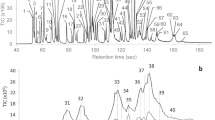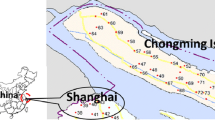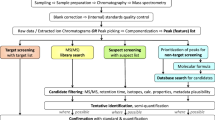Abstract
The use of an enzyme-linked immunosorbent assay (ELISA) to screen for polychlorinated dibenzo-p-dioxins and polychlorinated dibenzofurans (PCDD/F) has shown promise as a complementary tool to gas chromatography-high resolution mass spectrometry (GC-HRMS). This is especially true due to its low cost, ease of sample preparation and fast sample turnaround time. One problem that was unaddressed by other research is how to increase the efficiency of ELISA to a point that makes it practical for the analysis of large groups of samples that can have a wide range of unknown PCDD/F concentrations; one ELISA test is unable to screen for PCDD/F concentrations that can range anywhere from background levels to upwards of 10,000 picograms toxic equivalents per gram of soil (pgTEQ g−1). This paper resolves this problem by introducing a sample algorithm which enables the correct amount of dioxin to enter an ELISA tube from a sample (whose unknown PCDD/F concentration can range between 30 and 10,500 pgTEQ g−1) in only two ELISA runs. In doing so, the time and cost benefits of ELISA are preserved. ELISA results for soils and sediment samples processed using the algorithm were then plotted on two site maps alongside their GC-HRMS counterparts. A comparison of both analytical methods showed that areas of high and low PCDD/F concentrations were equally identifiable with either analytical tool; 29 of 32 sample locations on the site maps were placed into the same of three possible screening levels. Therefore, processing ELISA samples through the sample algorithm achieves the necessary level of efficiency while producing virtually equal screening results in comparison to GC-HRMS but at a fraction of the cost. The agreement between GC-HRMS and ELISA was 94 % (R 2 = 0.99, n = 53). GC-HRMS and ELISA results were significantly correlated (Wilcoxon signed rank test p < 0.001).

Dioxin-continated site mapped by ELISA (blue) and GC-HRMS (yellow) in pgTEQ per g of sediment







Similar content being viewed by others
References
Mandal P (2005) Dioxin: a review of its environmental effects and its aryl hydrocarbon receptor biology. J Comp Physiol B 175(4):221–230
Pesatori A, Consonni D, Bachetti S, Zocchetti C, Bonzini M, Baccarelli A, Bertazzi P (2003) Short- and long-term morbidity and mortality in the population exposed to dioxin after the “Seveso accident”. Ind Health 41:127–138
Environment Canada (1990) Priority substances list assessment report no. 1—polychlorinated dibenzodioxins and polychlorinated dibenzofurans. http://www.hc-sc.gc.ca. Accessed May 14 2009
Srogi K (2008) Levels and congener distributions of PCDDs, PCDFs and dioxin-like PCBs in environmental and human samples: a review. Environ Chem Lett 6:1–28
Birnbaum L, Tuomisto J (2000) Non-carcinogenic effects of TCDD in animals. Food Addit Contam 17(4):275–288
Mustafa A, Holladay S, Goff M, Witonsky S, Kerr R, Reilly C, Sponenberg D, Gogal R (2008) An enhanced postnatal autoimmune profile in 24 week-old C57BL/6 mice developmentally exposed to TCDD. Toxicol Appl Pharmacol 232:51–59
Schecter A, Birnbaum L, Ryan J, Constable J (2006) Dioxins: an overview. Environ Res 101(3):419–428
De Rosa C, Brown D, Dhara R, Garett W, Hansen H, Holler J, Jones D, Jordan-Izaguirre D, O’Connor R, Pohl H, Xintaras C (1997) Dioxin and dioxin-like compounds in soil, part 1: ATSDR interim policy guideline. Toxicol Ind Health 13(6):759–768
Ontario Ministry of the Environment (1996). Guidance on site specific risk assessment for use at contaminated sites in Ontario. http://www.ene.gov.on.ca. Accessed May 14 2009
Kutz F, Barnes D, Bottimore D, Greim H, Bretthauer E (1990) The international toxicity equivalency factor (I-TEQ) method of risk assessment for complex mixtures of dioxins and related compounds. Chemosphere 20(7-9):751–757
A.J. Chandler & Associates (2006) Review of dioxins and furans from incineration in support of a Canada-wide standard review http://www.ccme.ca. Accessed May 14 2009
United States Environmental Protection Agency (2005) Technologies for monitoring & measurement of dioxin and dioxin-like compounds in soil and sediment (CAPE Technologies LLC, DFI; dioxin/furan immunoassay kit; PCB TEQ immunoassay kit) http://www.epa.gov. Accessed May 14 2009
Li J, Lo C, Chen E, Sun F, Zhang W, Wang C, Lee A (2010) The screening of dioxins in fish using enzyme-linked immunosorbent assay (ELISA). Fresenius Environ Bull 5:783–789
United States Environmental Protection Agency (2002) Method 4025—screening for polychlorinated dibenzodioxins and polychlorinated dibenzofurans (PCDD/Fs) by immunoassay. http://www.epa.gov. Accessed May 14 2009
Tsutsumi T, Amakura Y, Ashieda K, Okuyama A, Tanioka Y, Sakata K, Kobayashi Y, Sasaki K, Maitanit T (2008) PCB 118 and aryl hydrocarbon receptor immunoassays for screening dioxins in retail fish. J Agric Food Chem 56:2867–2874
Van Emon J, Chuang J, Lordo R, Schrock M, Nichkova M, Gee S, Hammock B (2008) An enzyme-linked immunosorbent assay for the determination of dioxins in contaminated sediment and soil samples. Chemosphere 72:95–103
Nording M, Denison M, Baston D, Persson Y, Spinnel E, Haglund P (2007) Analysis of dioxins in contaminated soils with the CALUX and CAFLUX bioassays, an immunoassay, and gas chromatography/high-resolution mass spectrometry. Environ Toxicol Chem 26(6):1122–1129
Nording M, Nichkova M, Spinnel E, Persson Y, Gee S, Hammock B, Haglund P (2006) Rapid screening of dioxin contaminated soil by accelerated solvent extraction/purification followed by immunochemical detection. Anal Bioanal Chem 385(2):357–366
Nichkova M, Park E-K, Koivunen M, Kamita S, Gee S, Chuang J, Van Emon J, Hammock B (2004) Immunochemical detection of dioxins in soil and serum samples. Talanta 63(5):1213–1223
Shan G, Leeman W, Gee S, Sanborn J, Jones A, Chang D, Hammock B (2001) Highly sensitive dioxin immunoassay and its application to soil and biota samples. Anal Chim Acta 444(1):169–178
Canadian Council of Ministers of the Environment (2002) Canadian soil quality guidelines for the protection of environmental and human health—polychlorinated dibenzo-p-dioxins and polychlorinated dibenzofurans. http://www.ccme.ca. Accessed May 14 2009
Viswanathan CT, Bansal S, Booth B, Destefano AJ, Rose MJ, Sailstad J, Shah VP, Skelly JP, Swann PG, Weiner R (2007) Quantitative bioanalytical methods validation and implementation: best practices for chromatographic and ligand binding assays. Pharm Res 9:E30–E42
Cape Technologies (2003) Insert for DF1 dioxin/furan immunoassay kit. http://www.cape-tech.com/IN-DF1.pdf. Accessed May 14 2009
Cape Technologies (2002) AN-007 application note http://www.cape-tech.com. Accessed May 14 2009
United States Environmental Protection Agency (1994) Dioxins & furans—HRGC/HRMS http://www.epa.gov. Accessed May 14 2009
Buan E, Lo C, Zhang W, Li J (2010) Correction for discrepancies in dioxin quantification between immunoassay and gas chromatography-high-resolution mass spectrometry. Anal Bioanal Chem 398:2233–2241
Shen L, Gewurtz SB, Reiner EJ, MacPherson KA, Kolic TM, Khurana V, Helm PA, Howell ET, Burniston DA, Brindle ID, Marvin CH (2009) Occurrence and sources of polychlorinated dibenzo-p-dioxins, dibenzofurans and dioxin-like polychlorinated biphenyls in surficial sediments of Lakes Superior and Huron. Environ Pollut 157:1210–1218
Bland JM, Altman D (1986) Statistical methods for assessing agreement between two methods of clinical measurements. Lancet 327(8476):307–310
Acknowledgments
Thanks are due to the management team at the Ontario Ministry of the Environment, Laboratory Services Branch including Director Dr. Joseph Odumeru, Former Directors Dr. P.K. Misra and Dr. John Lynch, former Assistant Director Mr. Dan Toner and Former Manager of the Biological Analysis Section Mr. Frank Tomassini. Advices offered by Dr. Eric Reiner, Senior Mass Spectrometry Research Scientist, were extremely helpful. We thank the Environmental Monitoring and Reporting Branch for sample collection at the study site. Mr. Brian Sunga is gratefully acknowledged for his contribution to the statistical analysis portion of this paper.
This research was supported by the following funding:
1. Natural Sciences and Engineering Research Council of Canada Research Assistantship.
2. Ontario Ministry of the Environment academic funding agreement to Ryerson University 2006.
3. Ontario Ministry of the Environment, Best in Science academic research fund 2007 #1705.
4. Ontario Ministry of Research & Innovation, Ideas and Innovation Fund # 07083, #07083 follow-up augmentation fund and #08034.
Author information
Authors and Affiliations
Corresponding author
Ethics declarations
Conflict of interest
The authors declare that they have no conflict of interest.
Rights and permissions
About this article
Cite this article
Lo, C., Buan, E., Li, J. et al. Optimized efficiency of mapping a site contaminated with dioxins by immunoassay compared to gas chromatography-high resolution mass spectrometry. Anal Bioanal Chem 408, 1095–1105 (2016). https://doi.org/10.1007/s00216-015-9205-1
Received:
Revised:
Accepted:
Published:
Issue Date:
DOI: https://doi.org/10.1007/s00216-015-9205-1




